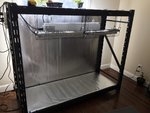cbrshadow23
Shohin
I recently brought my plants indoors since the temperatures are cooling down and we're getting into the wet/foggy season.
My plants are:
- Portulacaria Afra Cork Bark ("Dwarf Jade", "Elephant Bush", etc)
- Crassula Ovata (Jade)
I'm wondering if I have too much light on these plants to the point that I'm hurting/burning/bleaching them. Is this likely given the setup I have below?
- I'm using a shelving rack from Home Depot (65" x 30" x 60")
- Covered 5 sides in Diamond Print Mylar (Top is open)
Lighting:
- (1x) Fiet Electric 120W Full Spectrum LED. This is incredibly bright

 www.feit.com
www.feit.com
- (3x) "Hybrid" (T5 + LED) 80W each, 24" strips. (A friend of mine makes these)

Total energy pull is ~350w, measured by a meter.
The plants aren't getting a ton of heat, but I'm still running a fan across the lights to keep the heat down a bit.
The lights are on a timer, which I currently have running for 12 hours per day (5:00AM - 5:00PM).
I'm a bit worried that I'm providing too much light and doing harm to my plants. It's hard to tell how bright it is in the pictures below, since the camera adjusts for brightness, but it's incredibly bright.
I've seen on other forums where the standard response is "More light is better" but they're typically referring to pretty weak setups with 9W LED's in a large open room.
Questions:
1) Is it likely that I'm providing too much light to my plants?
2) Is 12 hours per day a good amount of time to run the lights? I can easily run more or less if needed.
3) Since I'm expecting them to grow this winter, should I still provide fertilizer?
Here are some pictures of the setup.




My plants are:
- Portulacaria Afra Cork Bark ("Dwarf Jade", "Elephant Bush", etc)
- Crassula Ovata (Jade)
I'm wondering if I have too much light on these plants to the point that I'm hurting/burning/bleaching them. Is this likely given the setup I have below?
- I'm using a shelving rack from Home Depot (65" x 30" x 60")
- Covered 5 sides in Diamond Print Mylar (Top is open)
Lighting:
- (1x) Fiet Electric 120W Full Spectrum LED. This is incredibly bright

3ft Full Spectrum LED Plant Grow Light - Feit Electric
Grow better, stronger plants with the Feit Electric Full Spectrum 3ft LED Grow Light. Rated for high humidity, it’s ideal for all phases of indoor plant growth and is suitable for soil or hydroponic gardens. Instant full brightness lamps are integrated directly into the fixture so there are no...
 www.feit.com
www.feit.com
- (3x) "Hybrid" (T5 + LED) 80W each, 24" strips. (A friend of mine makes these)

Hybrid LED/Fluorescent High Efficiency Grow Lights
Hybrid LED/Fluorescent High Efficiency Grow Lights - Combines the best attributes of LED and Fluorescent technology for a healthy and perfectly balanced high efficiency light output. - High Power...
sfbay.craigslist.org
Total energy pull is ~350w, measured by a meter.
The plants aren't getting a ton of heat, but I'm still running a fan across the lights to keep the heat down a bit.
The lights are on a timer, which I currently have running for 12 hours per day (5:00AM - 5:00PM).
I'm a bit worried that I'm providing too much light and doing harm to my plants. It's hard to tell how bright it is in the pictures below, since the camera adjusts for brightness, but it's incredibly bright.
I've seen on other forums where the standard response is "More light is better" but they're typically referring to pretty weak setups with 9W LED's in a large open room.
Questions:
1) Is it likely that I'm providing too much light to my plants?
2) Is 12 hours per day a good amount of time to run the lights? I can easily run more or less if needed.
3) Since I'm expecting them to grow this winter, should I still provide fertilizer?
Here are some pictures of the setup.




